Someone who I follow in the Fediverse posted a tiny, throwaway joke this morning:

I see what you did there, Rodney.
But also: Rodney’s post made me realize something: I have a did‑do list.1 I’m not talking about a “journal”, at least not how I normally understand the term: the only type of thing I put on my did‑do list are items that would belong on a typical todo (to‑do?) list (if they weren’t done yet). My did‑do list serves as a record of stuff I did, and crucially, includes even those action items where I went straight to doing, never going through the step of putting them on a todo list first.
The way I manage this is to have my daily todos and did‑dos in one document.2 When I finish a todo item, I move it from the todos list over to the did‑dos list. But when I notice that I’ve just completed a task that was never on the todo list to begin with, I type it straight into the did‑dos list.
Why do I find this good/helpful? For the last several months, as I have navigated my transition from academia back into tech, my daily environment has been extraordinarily unstructured. It’s not that I haven’t had lots to do; sometimes it has felt like quite the opposite, namely, that I have some forbiddingly large things to do. (If I was keeping a truly honest todo list, then last spring, for example, it would have had such things as like “Get used to thinking like an engineer again, and not like a scientist” on it.) But because there has been no set timetable for these things, and very few external impositions on my schedule, it has been very easy to fall into a certain kind of malaise. To feel like I’m not doing anything, or at least not doing what I “should” be doing. And this malaise, at least for me, has a way of turning into a kind of latent, misplaced shame, born of implicitly comparing myself to some hypothetical, unnamed alternate version of myself that’s somehow doing more (hypothetical, unnamed) things.
Also, it turns out to be exceedingly easy for me to forget about good, productive things that I have been doing. For example, during the month of June, I spent a large portion of my time training & otherwise acclimating the new dog that my wife and I adopted. But outside of those moments where I was actually engaged in that activity, it was way too easy to fall into the trap of thinking I “hadn’t done anything” that month. (Unless I thought about it very carefully, anyway.)
But by putting into practice this did‑do list habit, it suddenly became clear to me that I was doing all kinds of things, and in fact being quite productive. Over the course of these months between leaving academia & starting to look for a job in earnest, I reached out to various contacts in the industry to gather advice; looked at examples of résumés of people who had successfully landed jobs; checked in on various examples of the “latest & greatest” in the software world to verify that I had indeed been keeping myself as reasonably-up-to-date as I hoped I had; freshened up and updated my own personal dev environment; and on and on. To say nothing about the household & dog-related things I was getting done (and which I would have never gotten done or had time for, while I was still in academia). This all became harder to ignore in light of the did‑do list; and it would have been much easier to ignore if I had only a todo list, since a lot of these tasks are ones which, for whatever reason, I would have never written down as a todo item in the first place. But they were much easier to recognize as “a thing I did” in hindsight.
Having all of these completed tasks in writing proved to be a surprisingly effective bulwark against those illusions of idleness and the malaise they bring with them. The thing is, I stumbled onto this practice completely by accident; I never intended to make a did‑do list, it was just an unintended consequence of playing with a new todo-list platform (see note 2). And that’s what made me want to write about it and share this accidental insight.
Of course, for all I know, this is totally banal advice that’s well known in self-help-adjacent circles; or alternatively, it’s so idiosyncratic as to only be helpful to me and no one else. But to paraphrase a well-worn adage: it’s a free blog, and you get what you pay for! ;-)
Footnotes:
-
I hadn’t been referring to it as a “did‑do” list until I saw Rodney’s post, but now that I’ve encountered the term, I think it’s a fitting one. ↩
-
I use Obsidian (and in particular, an Obsidian setup inspired by this one). And while I really do love it, I believe that the issue here is for the most part about the practice, not about the tools. ↩ ↩2